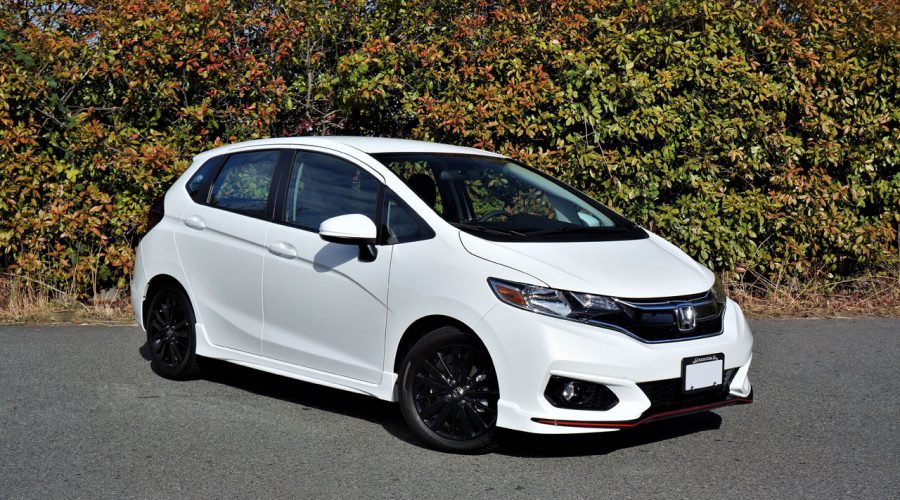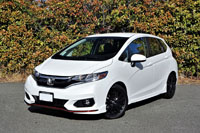
Honda’s Fit has always been a personal favourite in the subcompact class. Its hatchback design is practical, made more so by a tall roofline combined with the segment’s most flexible rear seating system, resulting in more cargo space than any rival, plus now that it’s received a refresh it’s more appealing than ever.
The 2018 Honda Fit facelift provides edgier styling, a new Sport trim line, and the availability of Honda Sensing advanced driver-assistance systems, the first factor improving the little wedge-shaped monobox design with a fresh take on the Japanese brand’s upswept horizontal grille that features more pronounced chrome and piano black slats plus a larger, more prominent “H” mark at centre. Additionally, new premium-like jeweled headlamp clusters meld more fluidly into that grille, while Honda has added a full-width splitter just below, as well as more angular corner “ducts” that get filled with sporty circular fog lamps in all trims above LX.
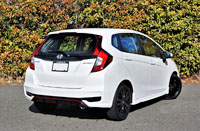
New combination taillights with LED brake lamps update the rear design, as does a reworked bumper, the latter feature now incorporating a full-width piano black character line as well as a splitter-inspired lower apron. Lastly, new Orange Fury paint is kept exclusively for an entirely new Sport trim level.
On that note, the 2018 Honda Fit is available in the same DX, LX, EX and EX-L Navi trims as last year’s version, now priced at $15,190, $18,590, 21,890 and $23,990 respectively, but new Sport trim starts at $19,590 and therefore slots between the LX and EX.
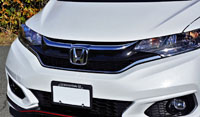
I don’t know about you, but the Fit Sport takes top spot as far as styling goes, as its standard aero kit adds muscle to the refreshed front, side and rear body panels resulting in a more aggressive look, plus bright orange pin-striping highlights the deeper front splitter and tri-strake rear diffuser, no matter the exterior colour chosen.
As much as I like the Fit Sport’s exclusive and standard Orange Fury paintwork, I love the contrast between the orange pin-striping and glossy black lower bodywork found with my tester’s $300 optional White Orchid Pearl, but if neither is to your liking Honda also provides $300 Crystal Black Pearl as a third available colour with this Sport trim. Of note, the colour palette isn’t as limited with the other trims, including Modern Steel Metallic (medium grey), Milano Red, and Aegean Blue Metallic.
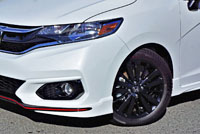
Finishing off the Fit Sport’s exterior is a set of gloss-black painted 16-inch alloys, plus a chromed exhaust finisher and “SPORT” liftgate badge.
The Fit Sport also boasts an all-black cabin with unique orange contrast stitching, a theme that really caught my eye. Honda stitches the leather-wrapped steering wheel, leather-clad manual shift knob and boot, front centre armrest, front seat bolsters, and all five headrests with the trendy orange thread, while the fabric inserts get an attractive geometric pattern highlighted with a little more orange for good measure. It’s a tasteful combination that should please sport compact performance fans stepping up to the Fit Sport model.
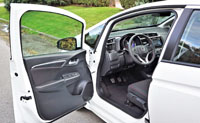
Sport trim comes with or without Honda’s available Honda Sensing system, a technologically advanced package that includes autonomous emergency braking, lane/road departure warning with mitigating assist, and adaptive cruise control, upping the Fit Sport’s price by $1,300, which is the same amount if added to the LX (it comes standard on EX and EX-L Navi trims). This is a really good deal when factoring in this new price also includes the optional continuously variable transmission (CVT), but at the same time take note that manually equipped cars, like my tester, don’t receive the same safety advantages.
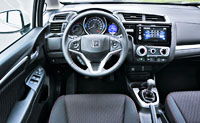
Also notable, Fits upgraded with Honda Sensing don’t include auto high beams, which is only an issue because Toyota has been equipping its competitive Yaris with similar advanced driver-assistance systems since the 2017 model year. The Honda rival also features a pre-collision system with autonomous emergency braking capability and lane departure alert, albeit no lane/road departure mitigation or adaptive cruise control. Still, that all of this active safety is available from its $15,475 base trim level is impressive.
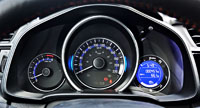
As is usual for mid-cycle makeovers the new 2018 Fit didn’t receive any updates under the hood, but with 130 horsepower and 114 lb-ft of torque on tap I can hardly complain. Also worth mentioning, Honda lightened up the base DX model by a significant 44 kilos (97 lbs), the changes likely trickling through Fit trim lines and therefore aiding performance of this new Sport as well. Either way, the direct-injection 16-valve, DOHC, i-VTEC-enhanced 1.5-litre four-cylinder felt plenty feisty when foot hit the throttle pedal, its quick response accompanied by a nice high-revving engine note and wonderfully smooth operation, while the standard six-speed manual was up to Honda’s usual DIY gearbox brilliance.
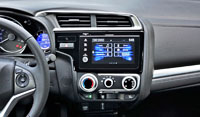
Option out the Sport with the CVT and along with the aforementioned Honda Sensing features it’ll also come with a nice set of steering wheel-mounted paddle shifters, a bonus that benefits EX and EX-L Navi trims too. I’ve experienced these before and they certainly increase driver engagement during downshifts, while offering the ability to upshift earlier to save fuel.
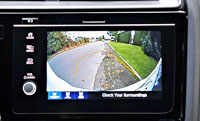
Yes, fuel economy once again matters in Canada. Of course, how much it will matter will depend on where you’re reading from, but in my hometown of Vancouver it’s a very serious issue (at the time of writing the cheapest pump price was 154.9 for regular). I won’t venture into politics on this platform, but we’re probably best not to believe highly charged issues like pipelines and carbon taxes, not to mention the rising price per barrel of crude, will be diffused anytime soon, plus on top of this are national and global economies that are shaky at best, so it’s probably a good time to keep ongoing costs down by choosing a thrifty car.
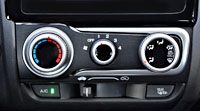
To that end, Honda claims an impressive five-cycle fuel economy rating of 8.1 L/100km city, 6.6 highway and 7.4 combined with the manual, 7.0 L/100km city, 5.9 highway and 6.5 combined with the CVT in LX trim, or alternatively 7.6, 6.5 and 7.0 combined in EX trim and above. This represents a marginal improvement when compared to last year’s claimed fuel economy.
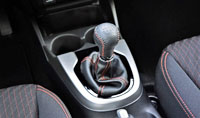
Long-time readers will know I’ve always appreciated the Fit’s driving dynamics, but the new 2018 version is even better. First off, Honda retuned the suspension dampers, while also making its electric power-assisted rack-and-pinion steering system a bit stiffer, and provided more rigidity to the body shell due to extra reinforcements. Along with handling this improves crash resistance, quietness and ride quality, the latter two excellent over my weeklong test.
My Sport model also had the advantage of the previously noted wheels and tires, adding an inch to DX and LX trims that come stock with 15-inch steel wheels and covers, but other than the performance gains allowed by its manual transmission, EX and EX-L Navi trims should handle just as well as they ride on 16-inch rims and rubber too, although take note the two upper trims don’t benefit from the performance gains allowed by a manual transmission.
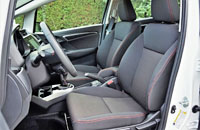
As for refinement, the stiffer body structure was joined by revised transmission and steering system mounting hardware, plus acoustic-laminated glass and increased insulation. Without a back-to-back comparison from old to new it’s difficult to notice such improvements, but on the positive I never had issue with the old model and certainly found the new one nice and quiet.
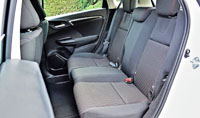
The Fit’s improved refinement is certainly not due to any upgrades in soft premium surfacing treatments, but the pliable synthetic bolstering on the instrument panel ahead of the front passenger continues to be a more upscale touch than some competitors while the quality of hard matte plastics is good for the class, plus the fit and finish is excellent and the upgraded trim details make this Sport model feel quite special. Along with everything already mentioned there’s plenty of satin aluminum-look accenting, a tasteful supply of piano black lacquer, and most importantly those segment-leading electronic interfaces noted earlier.
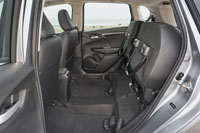
The carryover gauge cluster is a well lit, colourful mostly analogue affair that’s easy to read no matter the light, its rightmost dial filled with a handy multi-information display for quick access to key details, while the centre touchscreen grows from 5.0 to 7.0 inches in LX trim and above, and comes fitted with a bright and clear backup camera featuring dynamic guidelines, Apple CarPlay and Android Auto, Siri Eyes Free, text message functionality, Wi-Fi tethering, the HondaLink Assist automatic emergency response system, and a second USB port. Additionally, those who prefer adjusting audio settings from the radio display will appreciate a new rotating volume knob on the left side of the screen.
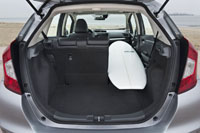
Other notable features pulled up to my Sport model from lesser trims include multi-reflector halogen headlights, heatable powered side mirrors, a rear rooftop spoiler, power locks with remote access, power windows, illuminated steering wheel-mounted switchgear, cruise control, tilt and telescopic steering, filtered air conditioning, Bluetooth mobile phone connectivity with streaming audio, four-speaker 160-watt AM/FM/MP3/WMA audio, two 12-volt power outlets, heatable front seats, the Fit’s unique 60/40-split second-row Magic Seat, 60/40 split-folding rear seatbacks, a cargo cover, cargo area tie-down hooks, front disc and rear drum brakes with ABS, and the usual assortment of active and passive safety features, while on top of everything already mentioned Sport trim adds auto-on/off headlights, two more stereo speakers and 20 additional watts of power to the audio system, plus more.
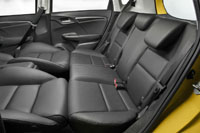
I always appreciate the little things that make the Fit’s interior so livable, like the pop-out cupholder on the left side of the steering wheel that lets you keep your drink a bit cooler or warmer depending on the temperature of air blowing through the vent just behind. This said I would’ve appreciated being able to get the Sport trim level with some of the features found on upper trims, such as the EX model’s proximity-sensing keyless access and pushbutton ignition, Honda’s awesome LaneWatch blindspot display that projects a rearward view of the passenger’s side lane onto the centre touchscreen, and powered moonroof, or the EX-L Navi’s automatic climate control, navigation, satellite and HD radio, etc.
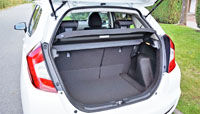
Still, it’s difficult to get too upset with any Fit trim level, as all come standard with the most configurable passenger/cargo setup in the subcompact class. For starters, with its rear seats laid flat a total of 1,492 litres (52.7 cubic feet) is available. Better yet, when the backrests of the Fit’s rear Magic Seats are upright it’s possible to flip their lower cushions upwards for yet more cargo capacity, especially helpful for loading in taller items like bicycles or plants, this combining for a collective 609 litres (21.5 cubic feet) of available cargo space when including the Fit’s dedicated luggage area in back, which measures 470 litres (16.6 cubic feet). What’s more, the front passenger’s seat can be folded forward to allow ultra-long cargo inside, while both front seats can be laid completely flat when their headrests are removed, providing a large safe place for impromptu camping.
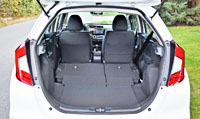
No competitor comes close to the Fit for passenger and cargo flexibility, yet even if it was only as useful as its peers behind the first row it would still be one of the best in its class, so make sure you check this little Honda out before choosing one of its challengers. Also important for you to know, Honda offers the identical seating setup and many of the same features in the Fit’s platform-sharing HR-V subcompact SUV, so even if your heart is set on a sport ute you can still enjoy this smart, efficient design. It appears Honda has all subcompact bases covered.

